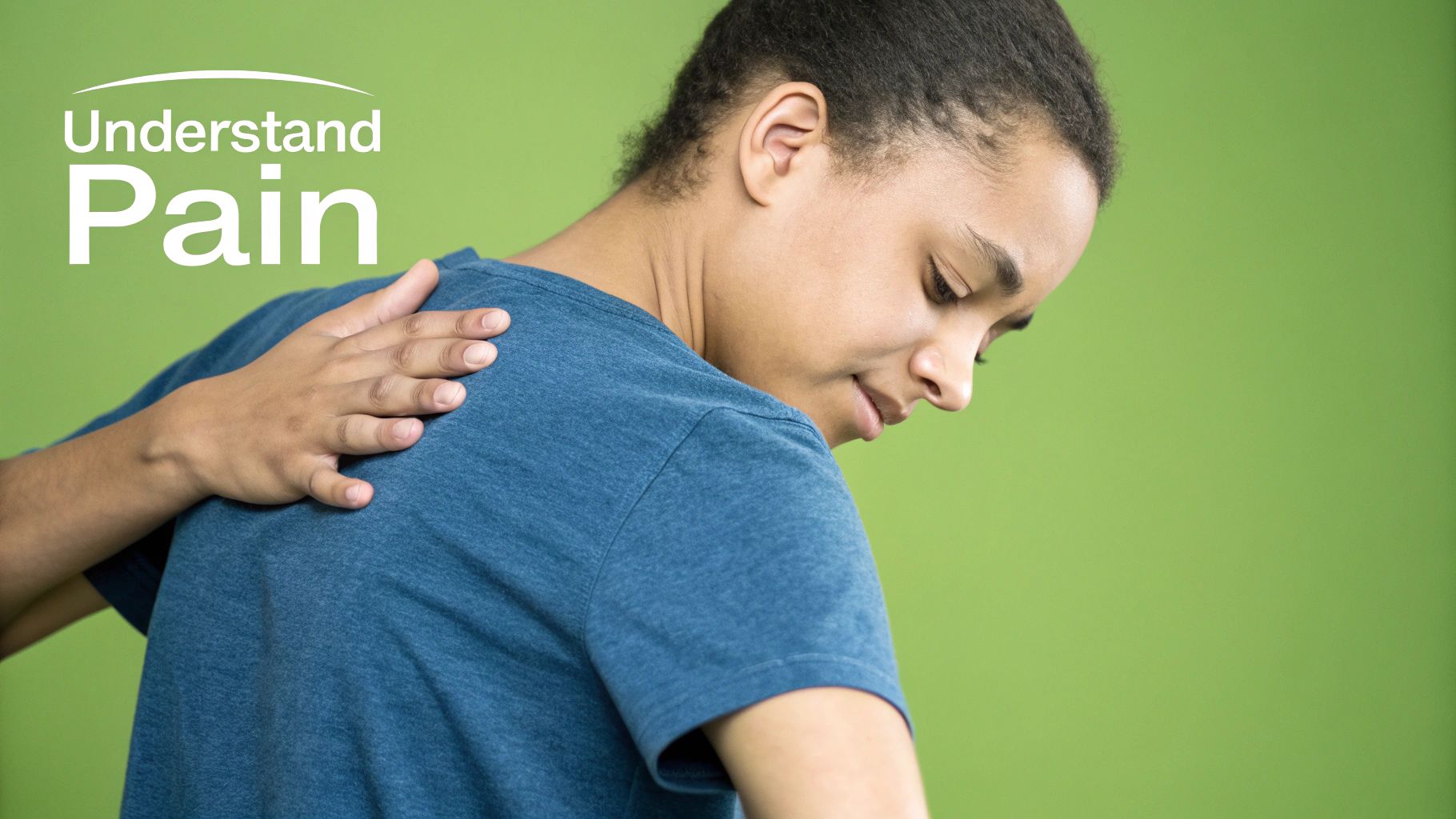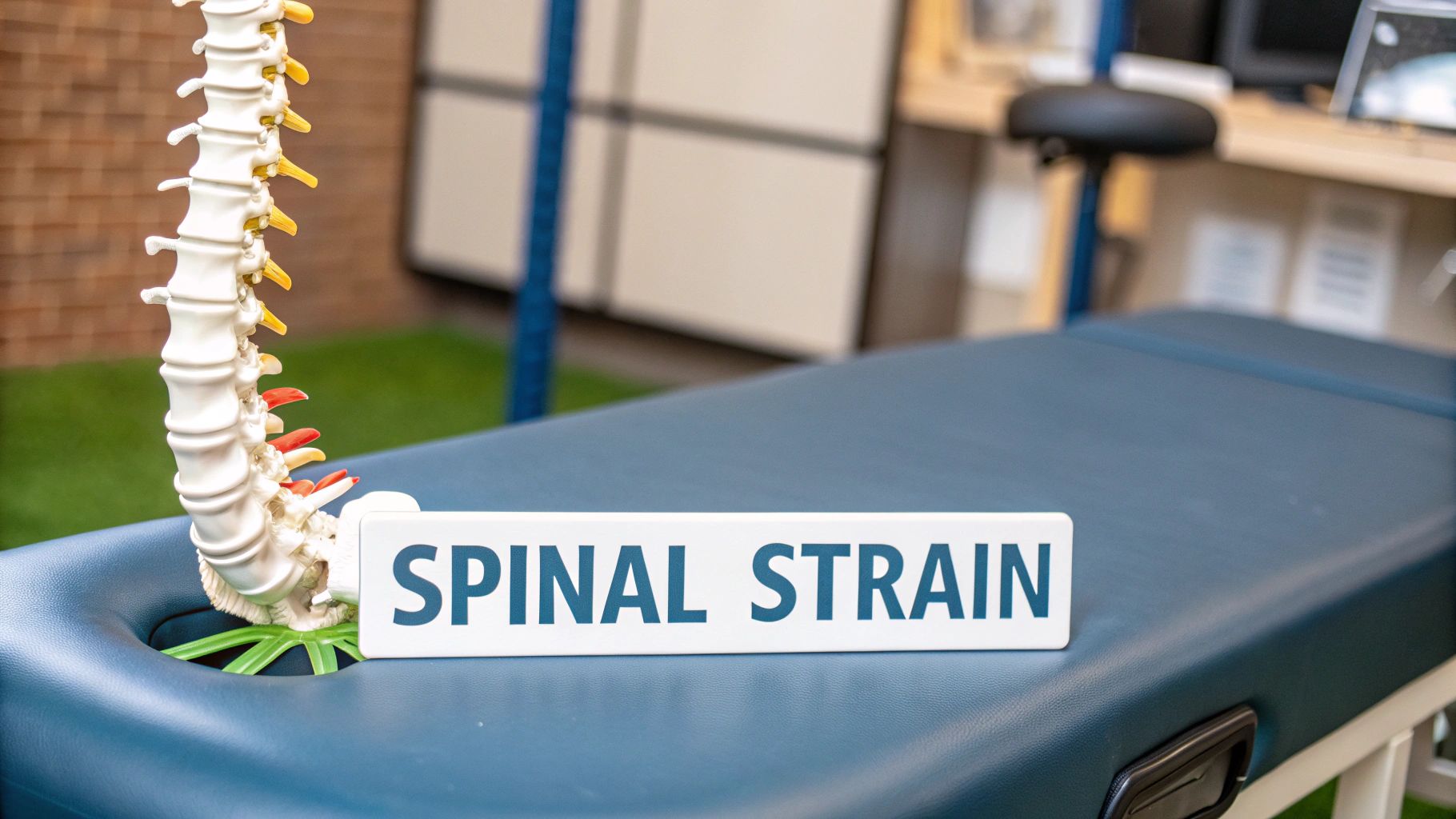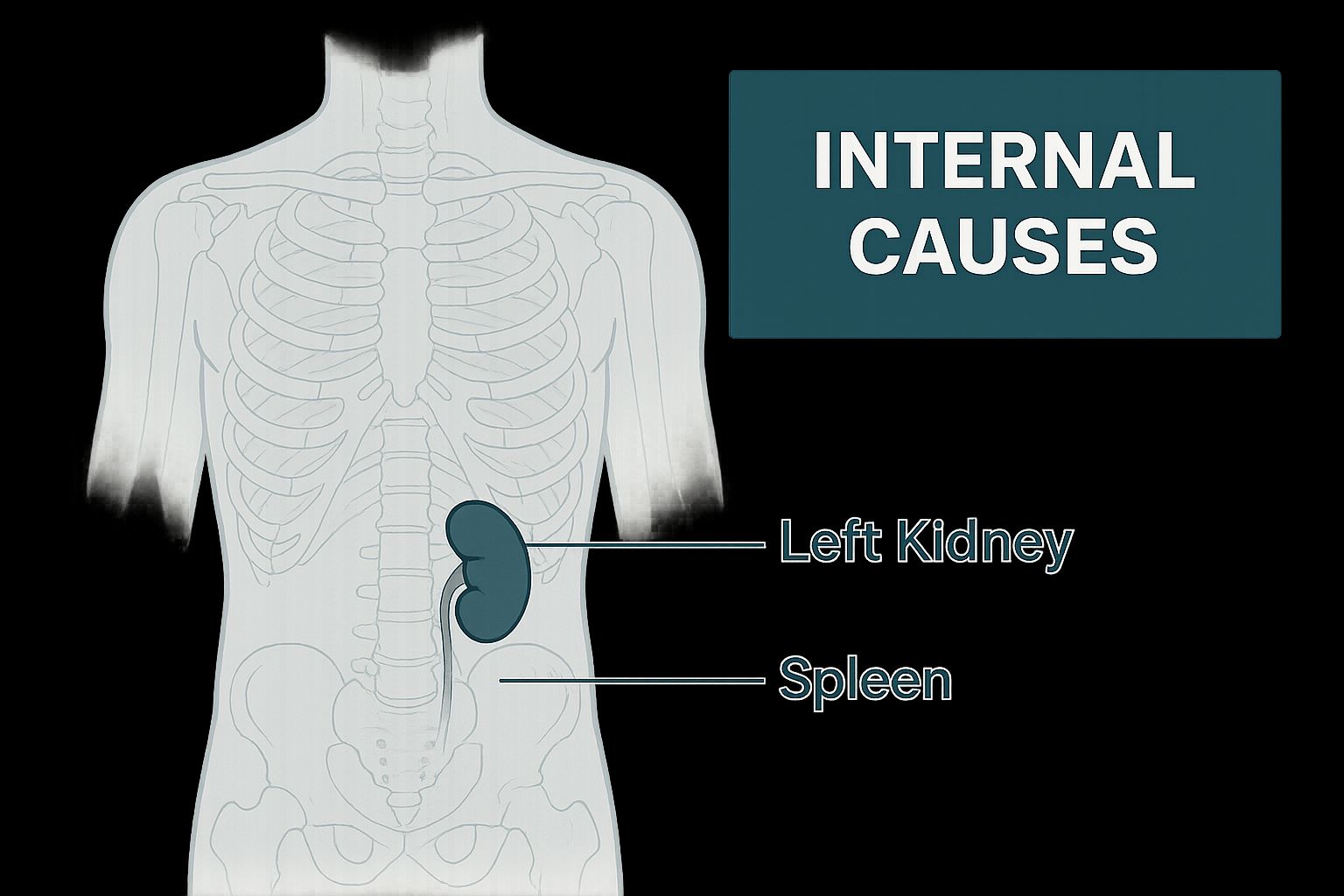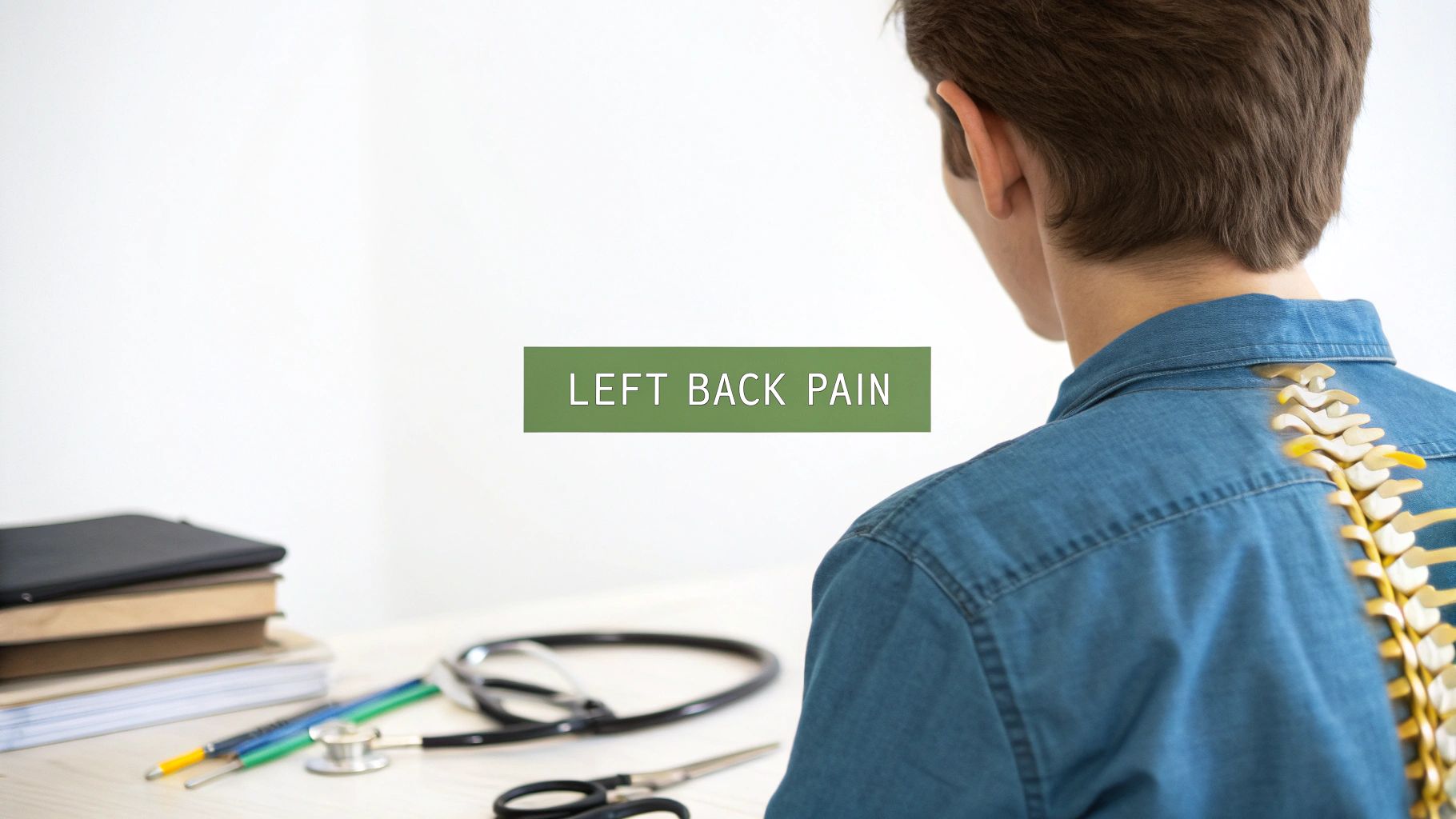.webp)
That nagging ache or sudden, sharp pain in your left-hand side is more than just a nuisance. It’s your body trying to tell you something. The cause could be as simple as a muscle strain from a long day at the desk, or it might point to something more complex involving internal organs like your kidneys or spleen. Learning to interpret the specific signals your body is sending is the crucial first step toward finding a solution.

Think of your back as the central hub of your body’s entire structure. A problem in one area can easily send signals that are felt somewhere else entirely. In fact, the pain you feel on your left side might not even be coming from your back muscles or spine at all. It could be what we call referred pain—a message from a nearby organ.
This guide is here to help you decode that message. We'll break down the possibilities, piece by piece, to give you a clear roadmap for understanding what’s going on. The goal is to replace that nagging uncertainty with clarity, helping you get to the bottom of your discomfort.
Back pain is one of the UK's most widespread health complaints. An estimated 9 million people in England alone live with some form of it. While specific figures for left-sided pain are hard to come by, we know that lower back pain—the category this discomfort falls into—is the country's single biggest cause of disability.
Of all those affected, around 61% (that’s roughly 5.5 million people) have pain severe enough to significantly get in the way of their daily lives. It’s a clear sign that this is an issue to be addressed, not ignored.
To properly tackle the pain in your left-hand side, you need to understand where it could be coming from. We’ll explore the main categories of causes to help you see the bigger picture. By the end of this guide, you’ll have a much better grasp of:
Figuring out the next steps can feel overwhelming, but a clear understanding is always the best place to start. For a general overview, you can check out our guide to addressing back pain.

More often than not, when you feel a pain in the left side of your back, the culprit is exactly where you’d expect: the back itself. Your spine, muscles, and ligaments work together as a complex support system. If one part of that system gets strained or injured, it can create a localised discomfort that’s hard to ignore.
This is what’s known as musculoskeletal pain, and it’s incredibly common. It usually comes from everyday activities we do without a second thought. Lifting a heavy box the wrong way, spending hours slumped over a laptop—these actions can place a huge amount of stress on the structures on one side of your body, leading to a strain.
One of the most frequent offenders is a straightforward muscle strain. This is what happens when the muscle fibres on the left side of your back get overstretched or even torn. You might feel it as a sudden twinge while you’re out gardening, or maybe it’s a dull ache that shows up after a workout where you favoured one side. The pain is usually sore, tender to the touch, and gets worse with certain movements like bending or twisting.
Poor posture is another massive contributor. Think of your spine as a tower of building blocks. If you constantly lean or slump to one side, the muscles on that side have to work overtime to stop the whole tower from toppling over. Over months or years, this chronic overuse leads to fatigue, stiffness, and a persistent ache often focused on that left side.
The cumulative effect of minor postural imbalances is often underestimated. A desk setup that is just a few centimetres off-kilter can, over time, lead to significant one-sided back pain as your body constantly tries to compensate.
Sometimes, the pain in your left back points to a deeper issue with the spine's structure. These problems go beyond surface-level muscle aches and can involve the bones (vertebrae) and the soft cushions between them (discs).
Common structural causes include:
Understanding the difference between these issues is the first step towards getting the right fix. Our guide to musculoskeletal pain offers more detail on how these conditions are diagnosed and managed. Unlike a simple muscle strain, these problems often need a professional assessment to prevent them from getting worse.
While we often blame muscles and bones for back pain, sometimes the real culprit is hiding deeper. The ache you feel in the left side of your back might not be coming from your back at all. This is something we call referred pain.
Think of it like faulty wiring in a house. A problem in the kitchen might make a light flicker in the living room because they share a circuit. In the same way, an issue with an internal organ can send pain signals along shared nerve pathways, tricking your brain into thinking the pain is coming from your back.
This is why a deep, nagging ache that doesn't get better with rest or change when you move could be a sign that something else is going on. Learning to spot the difference is key.
The infographic below shows which organs on your left side can cause this kind of referred pain.

As you can see, organs like the left kidney and spleen sit right up against the back muscles, making it easy to understand how a problem with them could feel just like a back strain.
Your kidneys are tucked in on either side of your spine, just under your ribs, which makes them a prime suspect for referred back pain. An issue with the left kidney often causes a deep and sharp pain in your left flank – that area between your lower ribs and hip.
Unlike a muscle strain, pain from a kidney problem is usually constant. It won’t ease up just because you've shifted your position on the sofa.
Common kidney issues include:
Distinguishing between musculoskeletal and organ-related pain can be tricky, as the initial sensation might feel similar. The key often lies in the accompanying symptoms and the nature of the pain itself.
The table below breaks down some of the common differences.
This table is a general guide, but remember that symptoms can overlap. The presence of those "accompanying symptoms" is often the biggest clue that something more than a simple strain is at play.
It's not just the kidneys. A few other neighbours in your abdomen and pelvis can also send pain signals to your back.
It's important to remember that organ-related back pain is almost always accompanied by other symptoms. Back pain is rarely the only sign of an internal issue.
Here are a few other potential sources to be aware of:
It's worth noting that chronic back pain – discomfort lasting more than three months – affects over 2.8 million adults in the UK. For many, this pain settles on one side. That’s why it’s so important to get to the root of the problem, whether it’s your muscles or something deeper. Paying close attention to any digestive troubles, fever, or changes in your toilet habits is crucial for deciding if your back pain needs a more urgent medical look.
While plenty of back pain triggers are universal, some are tied directly to our biology. Certain conditions unique to men or women can show up as a stubborn, nagging ache specifically on the left side of the back. Recognising these possibilities is key to getting a full picture of what might be going on.
For women, the culprit often lies in the pelvic region. Problems here can create inflammation or pressure that sends pain signals travelling upwards into the lower back. Think of it like a ripple effect—an issue starting in the pelvis can easily make its presence felt elsewhere.
This means that to get to the bottom of left-sided back pain, we sometimes have to look far beyond the back itself.
Several common gynaecological issues can cause this kind of referred pain. Women often describe it as a dull, constant ache rather than a sharp pain that comes and goes with movement.
Here are a few key conditions to be aware of:
Pregnancy is another major factor. As the uterus expands and your centre of gravity shifts, it puts a huge amount of strain on the muscles and ligaments in the lower back, often causing one-sided pain. Ovarian cysts can also be a source of discomfort. You can learn more about how they’re diagnosed in our detailed guide on ovarian cysts.
Though it’s less common, some gender-specific issues can cause left-sided back pain in men. Typically, this involves pain that radiates up from the groin or testicular area.
A crucial difference here is that this kind of pain is often sudden and severe—it’s an urgent signal that something is seriously wrong.
One such emergency is testicular torsion. This happens when a testicle rotates, twisting the spermatic cord and cutting off the blood supply. The result is sudden, intense pain and swelling that can radiate up into the abdomen and the lower left back. This is a medical emergency and needs immediate attention to prevent lasting damage.
Back pain affects millions of us, and gender can play a real role. Projections suggest that by 2030, around 5.8 million women and 3.4 million men in the UK over 50 may be dealing with back pain episodes, with women generally reporting it more frequently. You can find more details on these back pain prevalence trends in the UK. Paying attention to these gender-specific clues can help you and your doctor connect the dots faster.
When you walk into a doctor's office with pain in the left side of your back, you’re starting a process of detective work. A good diagnosis isn't a single "aha!" moment; it's a careful investigation designed to rule things out one by one until the real culprit is found. It all kicks off with a simple chat.
Your GP’s first and most powerful tool is your story. They'll want to know more than just "where does it hurt?". Get ready to describe the pain itself. Is it a dull, constant ache or a sharp, shooting pain? Does it stay put, or does it seem to travel down your leg? These details are the first clues that help your doctor build a working theory.
Next comes the physical exam. Your doctor will likely ask you to bend forward, lean back, and twist side-to-side to see how well you can move. They’ll also gently press on different spots on your back and even your abdomen, feeling for any tenderness, tightness, or anything that just doesn’t feel right.
If the initial check-up points towards something more complex than a simple muscle strain, your doctor will suggest some further tests. Think of these as bringing in the specialists for the investigation.
It's worth remembering that the goal here isn't just to find something wrong. A perfectly clear scan is just as useful as one that shows a problem, as it tells your doctor to focus their search elsewhere.
Most back pain isn't an emergency and will get better with time and sensible care. However, some symptoms are red flags—signals that something more serious is going on and you need to act fast.
You should seek emergency care immediately if your left-sided back pain comes with any of these:
Knowing these warnings empowers you to make the right call when it matters most. For everything else, a methodical approach with your GP is always the best way forward.
Once you have a better idea of what might be causing the pain in the left side of your back, the next step is finding a way to feel better. The right approach depends entirely on the root cause, but the journey nearly always starts with simple, supportive measures you can take at home.
For minor musculoskeletal issues like a simple muscle strain, this kind of conservative care is incredibly effective. The goal is to calm inflammation, ease muscle tension, and give your body the chance to heal itself without making things worse. This is the foundation of a good recovery.
Getting these first steps right is crucial for managing the immediate discomfort and stopping a minor issue from turning into a nagging, chronic problem.
Most cases of left-sided back pain, especially those from strains or poor posture, respond really well to self-care. The trick is to act quickly and listen to what your body is telling you.
One of the most popular first-line treatments is temperature therapy. Simple, but it works.
Gentle movement is also vital. While you should definitely avoid anything that causes sharp pain, staying completely still can make your muscles even stiffer. Light, gentle stretching that focuses on your back, shoulders, and hips will help you maintain flexibility and ease that built-up tension.
Over-the-counter pain relievers, like ibuprofen, can also offer temporary relief from inflammation and discomfort. Just be sure to always follow the instructions on the packet and have a word with a pharmacist if you have any other health conditions.
If home care isn't cutting it after a few days, or if the pain is severe from the get-go, it’s time to call in the professionals. Therapists can provide targeted treatments that go far beyond basic self-care.
Physiotherapy is often the cornerstone of back pain recovery. A good physio will assess your movement patterns, pinpoint any muscle imbalances, and create a personalised exercise programme just for you. This doesn't just relieve your current pain; it strengthens your core and back to help prevent it from happening again.
When looking at natural relief, targeted back pain massage therapy offers some very effective solutions. A qualified therapist can get to work on specific muscle knots and areas of tension, providing significant relief. Chiropractic care is another avenue, focusing on spinal alignment to improve function and reduce pain.
For more persistent or complex issues, a specialist may be required. They can offer a wider range of treatments designed to address the specific source of your pain.
For chronic or severe pain that just isn't responding to other therapies, medical interventions may be the next step. These are usually only considered after a thorough diagnosis has confirmed a specific structural or nerve-related problem.
Prescription medications, such as stronger anti-inflammatories or muscle relaxants, might be used for short-term relief to break the pain cycle. In cases where a specific joint is the culprit, injections can be highly effective. For instance, if inflammation of the sacroiliac joint is causing your lower left back pain, learning more about a sacroiliac joint injection can give you insight into a targeted treatment that delivers anti-inflammatory medication right to the source.
In rare cases, surgery might be on the table for issues like a severe herniated disc that is causing significant nerve compression. The best path forward is always a collaborative decision you make with your healthcare team, weighing up all the options.
We get asked about left-sided back pain all the time. Here are some of the most common questions we hear, with straightforward answers to help you make sense of what might be going on.
Yes, absolutely. When you’re stressed or anxious, it's incredibly common for your body to tense up without you even noticing. The neck, shoulders, and back are the usual suspects.
If this tension becomes chronic, it can fatigue the muscles and lead to painful knots, often called trigger points. It’s very easy for this kind of discomfort to settle on just one side of your body, making stress a very real cause of left-sided back pain.
This is a tricky one, but there are some key differences to look out for. Kidney pain usually feels deeper and higher up your back, just below the rib cage. It’s often a sharp, severe ache that doesn't get better or worse when you shift your position.
The real giveaway is that kidney pain often comes with other signs, like a fever, nausea, or a burning sensation when you wee. Muscle pain, on the other hand, tends to feel more like a surface-level ache or soreness that changes—either improving or worsening—as you move around.
While back pain can be a symptom of a heart attack, it’s extremely rare for it to be the only one. It would almost always be accompanied by the more well-known, classic signs.
You need to be on high alert for these red-flag symptoms:
If your back pain happens alongside any of these other symptoms, you must get emergency medical help immediately.
At The Vesey, our team of specialists is dedicated to accurately diagnosing the cause of your back pain and developing an effective treatment plan. Explore our services and book a consultation today.

